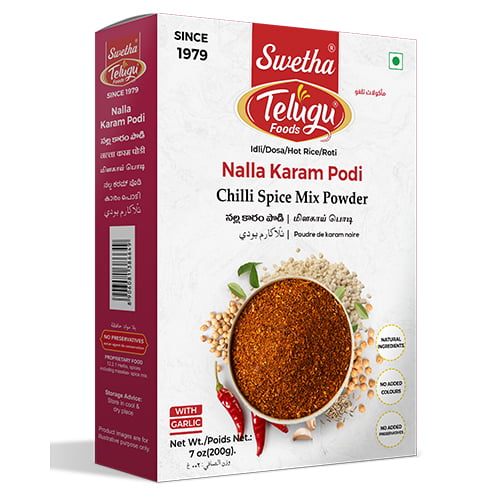Understanding Nalla Karam: A Culinary Treasure of Telugu Cuisine
Nalla Karam, a quintessential spice blend from the Telugu region of India, embodies the culinary richness and cultural heritage of Andhra Pradesh and Telangana. This iconic dish, which translates to “black spice,” has origins deeply rooted in the traditional practices of Telugu households. Historically, Nalla Karam emerged as a way to enhance the flavor of various meals, showcasing the creativity and resourcefulness of local cooking.
At its core, Nalla Karam is a vibrant mixture of roasted spices, including black sesame seeds, red chili, cumin, and various aromatic herbs. These ingredients, when combined, create a unique flavor profile, marked by a delightful balance of heat and nuttiness that distinguishes it from other Indian spice blends. The preparation involves roasting and grinding the ingredients to achieve a fine powder that can be used as a seasoning in numerous dishes, making it an integral part of Telugu cuisine.
The culinary significance of Nalla Karam extends beyond mere taste; it plays a pivotal role in traditional meals and festive occasions. This spice blend is often served alongside steaming hot rice and ghee or used as a topping for snacks, accentuating the flavors and transforming everyday meals into celebratory feasts. In many households, Nalla Karam is a staple that traces back generations, reflecting not just a method of cooking but also a way of life deeply ingrained in cultural traditions.
As it has gained popularity beyond regional borders, Nalla Karam has captured the attention of food enthusiasts worldwide. Its versatility allows it to pair with a variety of cuisines, making it a sought-after ingredient not just in Indian cooking, but also for international culinary explorations. This widespread admiration is a testament to its unique flavor and significance, showcasing the potential of Nalla Karam as a global culinary treasure.
Nalla Karam’s Global Distribution: Challenges and Opportunities
Nalla Karam, a traditional Telugu dish, has gained recognition within regional markets but faces significant challenges in its journey to global distribution. One of the foremost obstacles is branding. Many international consumers are unaware of this dish’s cultural significance and flavor profile, which could hinder acceptance. Developing a compelling brand narrative that showcases the authenticity and heritage of Nalla Karam can contribute to its desirability among consumers looking for unique culinary experiences.
Another challenge is packaging. Nalla Karam must be thoughtfully packaged to preserve the integrity of its ingredients and flavors while also appealing to global tastes and preferences. Sustainable packaging options could be leveraged to attract environmentally conscious consumers, which is increasingly crucial in the contemporary market landscape. Creative packaging designs that highlight the dish’s traditional roots while being functional for international logistics will enhance its appeal.
Furthermore, consumer awareness presents another challenge. To foster recognition and acceptance, targeted marketing campaigns are essential. By utilizing social media platforms effectively, producers can create engaging content that educates potential consumers about Nalla Karam’s unique qualities, preparation methods, and various culinary applications. Highlighting partnerships with local distributors can also accelerate outreach, ensuring that Nalla Karam reaches broader demographics.
Despite these challenges, there are significant opportunities for Nalla Karam in the global market. Participation in food expos and culinary festivals can elevate its visibility and allow producers to connect directly with potential partners and consumers. Additionally, collaborations with international influencers and food bloggers who appreciate ethnic cuisines can further amplify its reach. Tailored marketing strategies that resonate with diverse target audiences will ultimately support Nalla Karam in carving a niche for itself in the vibrant landscape of global culinary trends.













Reviews
Clear filtersThere are no reviews yet.